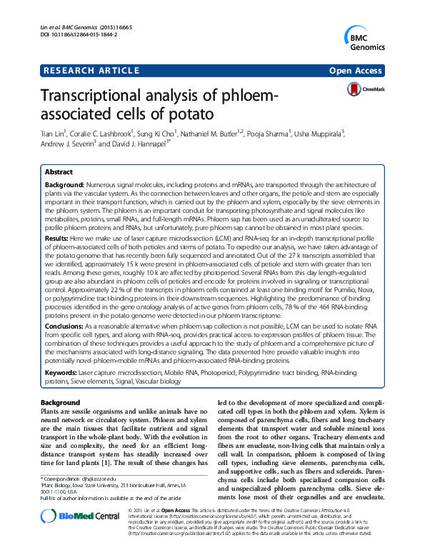
Article
Transcriptional analysis of phloem-associated cells of potato
BMC Genomics
Document Type
Article
Disciplines
Publication Version
Published Version
Publication Date
9-3-2015
DOI
10.1186/s12864-015-1844-2
Abstract
Background Numerous signal molecules, including proteins and mRNAs, are transported through the architecture of plants via the vascular system. As the connection between leaves and other organs, the petiole and stem are especially important in their transport function, which is carried out by the phloem and xylem, especially by the sieve elements in the phloem system. The phloem is an important conduit for transporting photosynthate and signal molecules like metabolites, proteins, small RNAs, and full-length mRNAs. Phloem sap has been used as an unadulterated source to profile phloem proteins and RNAs, but unfortunately, pure phloem sap cannot be obtained in most plant species.
Results Here we make use of laser capture microdissection (LCM) and RNA-seq for an in-depth transcriptional profile of phloem-associated cells of both petioles and stems of potato. To expedite our analysis, we have taken advantage of the potato genome that has recently been fully sequenced and annotated. Out of the 27 k transcripts assembled that we identified, approximately 15 k were present in phloem-associated cells of petiole and stem with greater than ten reads. Among these genes, roughly 10 k are affected by photoperiod. Several RNAs from this day length-regulated group are also abundant in phloem cells of petioles and encode for proteins involved in signaling or transcriptional control. Approximately 22 % of the transcripts in phloem cells contained at least one binding motif for Pumilio, Nova, or polypyrimidine tract-binding proteins in their downstream sequences. Highlighting the predominance of binding processes identified in the gene ontology analysis of active genes from phloem cells, 78 % of the 464 RNA-binding proteins present in the potato genome were detected in our phloem transcriptome.
Conclusions As a reasonable alternative when phloem sap collection is not possible, LCM can be used to isolate RNA from specific cell types, and along with RNA-seq, provides practical access to expression profiles of phloem tissue. The combination of these techniques provides a useful approach to the study of phloem and a comprehensive picture of the mechanisms associated with long-distance signaling. The data presented here provide valuable insights into potentially novel phloem-mobile mRNAs and phloem-associated RNA-binding proteins.
Rights
This article is distributed under the terms of the Creative Commons Attribution 4.0 International License (http://creativecommons.org/licenses/by/4.0/), which permits unrestricted use, distribution, and reproduction in any medium, provided you give appropriate credit to the original author(s) and the source, provide a link to the Creative Commons license, and indicate if changes were made.
Copyright Owner
Lin et al.
Copyright Date
2015
Language
en
File Format
application/pdf
Citation Information
Tian Lin, Coralie C. Lashbrook, Sung Ki Cho, Nathaniel M. Butler, et al.. "Transcriptional analysis of phloem-associated cells of potato" BMC Genomics Vol. 16 (2015) p. 665 Available at: http://works.bepress.com/andrew-severin/9/

This article is from BMC Genomics 16 (2015): 665, doi:10.1186/s12864-015-1844-2. Posted with permission.